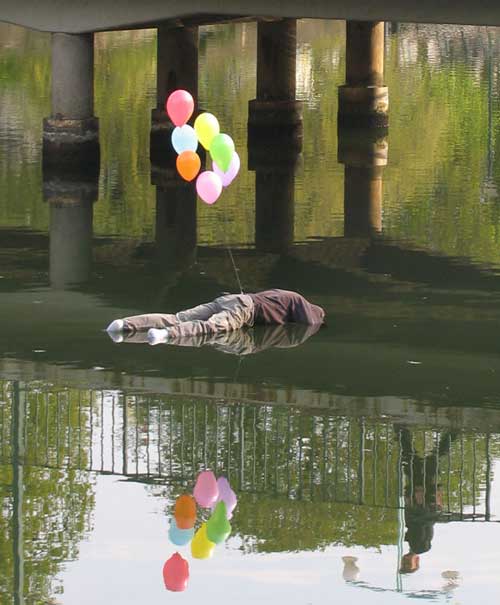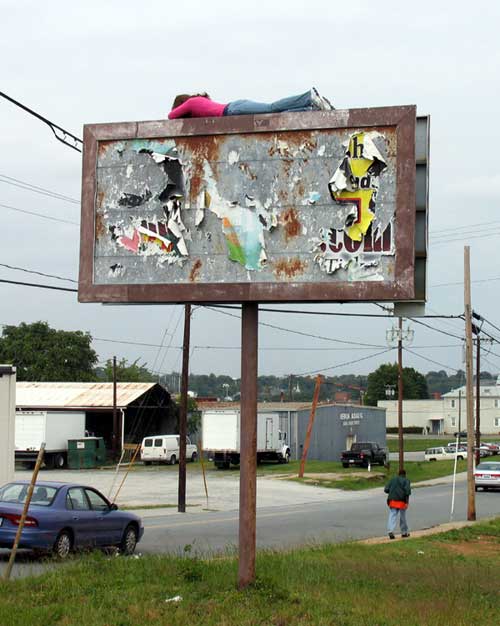
 Sculpture News at SculptSite.com
Sculpture News at SculptSite.com
Mark Jenkins Life-Like Sculpture |
| Rueters.com By Sarah Marsh A Minute With: Street artist Mark JenkinsFeb 1 (Reuters) - American street artist Mark Jenkins's human sculptures staged in provocative poses in the middle of cities have proved so uncannily life-like they have sparked calls from passersby to the ambulance service or the police. Dressed casually in a black baseball cap, baggy trousers and sneakers, the softly spoken Jenkins told Reuters he started his career by placing a figure in a refuse dump in Rio de Janeiro to draw attention to children living in the streets. The 41-year-old, who has worked as a saxophonist and web designer prior to becoming one of the foremost artists in the street installation movement -- based on surprising people with the unexpected in a familiar urban environment -- wants people to look up for a second from their mobile phones and engage with the world around them. Not all his installations are charged with social critique. One entire series consists of sculptures made using the casts of baby dolls installed in cheeky situations. One baby was placed on an underwear billboard to appear to be suckling a woman's breast. Others could be found climbing trees. Jenkins was in Berlin to launch his first monograph "The Urban Theater" and to open his first solo gallery show in Germany, "Glazed Paradise", which runs until Feb 26. While his works, made with thick, transparent, box-sealing tape then sometimes clothed are primarily made for interaction on the street, the exhibition includes both photographs of installations in situ and some new sculptures. Q: How did you start making tape sculptures? A: "I started off making balls in tape and soon I made a cast of my whole arm in tape. I decided to wrap my whole body in tape, but I wrapped the tape around my torso too tight, the hairs got caught, so I started cutting myself out which was really bloody - and thought I was going to die! From then on I used a mannequin torso, still using my own body for the legs." Q: What's it like seeing a sculpture of yourself on the street? A: "I love having a more personal connection with my sculptures ... you see yourself projected into these urban situations, it's like an out-of-body experience." Q: What are the babies about? A: "I was trying to start a campaign, like a graffiti artist would with a tag -- apart from I did it with an invasion of babies. "I felt I had introduced a new medium and the baby was symbolic of that, as well as being symbolic of not being cared for like insects that have to care for themselves. Also it was a way to experiment, an exercise in space. Q: How do you earn a living as a street artist? A: "In 2007 I had my first solo show in London and started selling works, plus I've done some publicly funded art projects. Q: Do you mind that your installations often get destroyed? A: "It's all part of the dynamic of street art, which really appeals to me. It's a social experiment, so I don't mind if a sculpture disappears, that's part of its life-cycle." Q: Why do you do these installations? A: "I like getting people to question their surroundings, what is real and what isn't. These days, people are so buried in their mobile phones and I just wanted to get them to look up. So at the beginning, I was collecting social data about people's reactions. But six years later, these images are more about poetry, of capturing a magical moment." Q: There is a dark streak running through your work; some of your sculptures are to be found lying face down in rivers or hanging upside-down like a cocoon from a tree. A: "They often tend to be marginalized individuals, sometimes in lonely states, so it's poetic but also dark. For example, the guy in the river is holding a bunch of colored balloons that are almost trying to magically lift him out. There's always an undercurrent of hope. "A lot of people identify with these characters that are neglected and melancholic, and they approach them to be helpful. My street art enables me to communicate with the rest of the world on a deeper level." Q: Are you attached to your sculptures? A: "If there was an apocalypse, I would probably make these people, they seem nice; I don't have a house but if I did, I would want them sitting around. Maybe I find it somehow therapeutic." |
 It just doesn't get much more real than Mark Jenkins incredibly life-like sculptures! All I can say to Mark is keep sculpting as your work takes our mind off the ever so connected world, even for just a moment! Although, you will not forget the moment... Great interview by Sarah Marsh! |
 Floating facedown in Malmö by Mark Jenkins |
 Billboard in Winston-Salem by Mark Jenkins |
More Sculpture News ....
Submit your SCULPTURE NEWS.
It's easy, just send us an e-mail
(click on Submit News in the left menu) with your pertinent information along with images, we'll take care of the rest. Sculpture makes our world a much better place in so many ways!
SculptSite.com, along with Sculptors and their creative genius all helping to bring the beauty and message of Sculpture to a hurried world.

